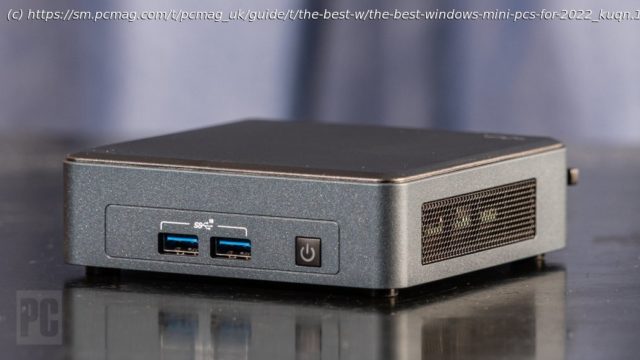Some are bare-bones kits. Others are ready to go out of the box, complete with an OS, RAM, and memory installed. Whatever the form, these top Windows micro desktops all deliver surprising features, value, and pep for their size.
The term „microcomputer“ has its origins in the 1970s—the „micro“ of the personal computers emerging then lay in stark contrast to the room-size mainframe beasts of the day. But fast-forward half a century or so, and—oh, micro, how you have changed!
Most of the acceleration toward super-small in desktop PCs has happened over the last decade. Of course, it’s still easy enough to find ordinary business boxes and hulking power towers packed with big video cards and multiple platter-based hard drives. But starting with the „small-form-factor“ (SFF) PC revolution of the ’00s, many desktops have gone from half-size towers to compact cubes to, in their most extreme reduction, sticks not a whole lot bigger than a USB flash drive.
A big reason why? Graphics acceleration and other essential features, handled in the past by separate chips or bulky cards, have been subsumed under the CPU. Nowadays, small-ification is getting to the point where you can’t go all that much smaller. You need to leave some space for ports to plug in a thing or two.What Is a Mini PC Good For? What Are the Different Kinds?
We’re seeing some clear stratification in the market for tiny desktop PCs. The very smallest PCs might be termed the „stick class,“ vanguarded by the Atom-CPU-powered Intel Compute Stick we first reviewed in early 2015 (and again in its refreshed, Cherry Trail Atom and Core m3 forms in 2016), followed by similar sticks from Asus, Azulle, Lenovo, and others.
These are really only suitable for display/signage use or extremely basic applications, and after a promising debut a several years back, have not seen all that much evolution or momentum. You can still find them on the market, but they have failed to have a major impact. A few vendors (notably, Azulle) still make them, though.
The models next up in size are a bit more dynamic, a bunch we might term the „NUC class.“ NUC stands for „Next Unit of Computing,“ a longtime initiative by Intel to spur the development of very small Windows-based desktop PCs using its mobile-centric processors. The chip giant has released a series of NUC-branded mini-PC kits in its own line, and several of the traditional PC-component makers have followed suit with similar models (Asus with its VivoMini line, and Gigabyte with its Brix models, for example).
The NUC PCs and their ilk tend to be around 5 or 6 inches square, though Intel’s 2020 NUC 9 Extreme (followed on by a 2021 NUC 11 Extreme version) changes this somewhat. The NUC 9 was a new mini-PC platform that Intel is encouraging partner manufacturers to utilize for many different types of PCs, based on a core-computing module called the Compute Element. While it’s technically a mini PC, full retail models from partners, such as the Razer Tomahawk, can be much larger than the small square boxes we’re used to associating with NUCs.
Separate from those is a host of PCs that are undeniably small but follow their own shape and size rules. Zotac, a major player in small PCs (and one of the category’s unsung early innovators), offers a huge range of Zbox PCs that range in size from a fat smartphone to a bulky Discman. Shuttle, too, is another small-PC pioneer, offering machines in a host of shapes. On the macOS side of things, the venerable Apple Mac Mini is a sleek, square silver box with rounded edges that saw a big update in late 2020. Like the MacBook Air and MacBook Pro, it received Apple’s homegrown M1 processor, greatly increasing its performance.Should You Buy a Bare Bones or Fully Configured Mini PC?
Not all mini PCs ship as complete systems; more so than any other class of PC, they tend not to.
Especially in the case of Intel’s NUC kits, Shuttle’s small PCs, and many of Zotac’s Zboxes, you get what amounts to a PC kit: a tiny chassis with a motherboard pre-installed.






